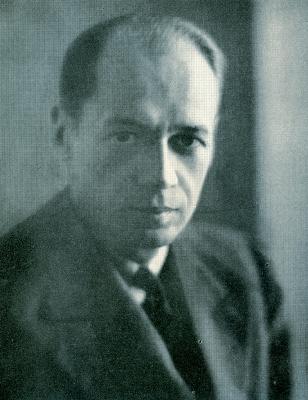
Edward Winter
(2005, with updates)

Eli Culbertson
‘“All bridge and chess players are slightly cuckoo.” – Ely Culbertson, bridge expert.’
The above quotation (the fors and againsts of which we cagily pass over) appeared on page 313 of CHESS, 14 May 1939. No source was given, and it is thus difficult to determine whether Culbertson did make such a remark and, if so, in which context. We recall no observation of the kind in his lengthy (and unindexed) autobiography, The Strange Lives of One Man (Chicago, 1940), although it does contain several references to chess.
The best known of these is too familiar to be repeated here: Culbertson’s account of Emanuel Lasker’s application to him for a teaching certificate for bridge. It appeared on pages 552-553 of the book and has been reproduced a number of times (e.g. by D.J. Morgan on page 460 of the October 1975 BCM).
Ely Culbertson (1891-1955) was in Paris during the First World War and wrote on pages 335-336 of his book:
‘Cards and card games, long my favorite pastime, now became the subject of scientific experiment. I was fascinated by cards – their origin, their structure (so similar to that of their cousin, chess); and their bizarre world, with its own logic and abstractions.
Thus I lived for nearly two years in my ivory tower, growing more learned but more morbid. I had few outside interests, no friends. Occasionally I played chess, bridge and poker ...’
From pages 386-387:
‘Within a few weeks I accumulated enough money to move over to a game of plafond at the Café [de la] Régence, which was and still is a famous chess center. There Bonar Law, who was later Prime Minister of England, used to play chess with Russian revolutionists; and Isaac Rice, the father-in-law of P. Hal Sims, used to bend all his energies and spend a great deal of money with chess professionals in propaganda for the Rice Gambit.’
Below is the inscription by Culbertson in our copy of The Strange Lives of One Man:
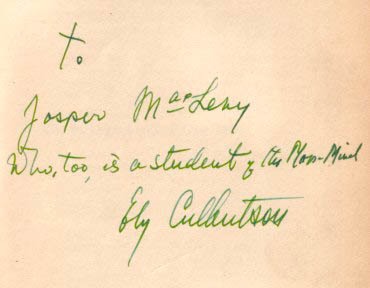
The following passage appeared on pages 416-417 and relates to the early 1920s:
‘I had occasionally dropped in at Frank Marshall’s Chess Club for a game of chess. There I had watched a bridge game which ran daily at half a cent a point. The bidding and play were atrocious, and I had often reflected that even at half a cent a point I should easily make a couple of hundred dollars a month ...
... I took a Fifth Avenue bus for my first hunting expedition in Greenwich Village.
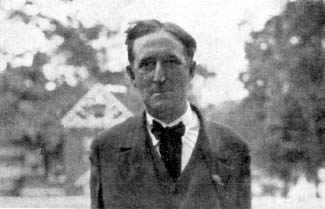
Frank Marshall and his charming wife greeted me cordially. Instead of playing chess, however, I asked if I could cut in at a bridge table.
“Do you play auction?” Everyone was surprised.
“A little.”
I was received with that naïve alacrity peculiar to many bridge players, who regard every stranger as a customer. Their hopes were amply confirmed as I started to play. Such bizarre, unconventional, crazy bidding had never been seen before.
No wonder – I was the only player in the world who then played the Culbertson System.
That night Janowsky, one of the world’s greatest chess champions, who also fancied himself a master at auction, was playing at my table. His luck was running badly, and he suggested that we double the stakes and play for a penny. Since everyone was already playing on Janowsky’s losses, it was agreed; and later we doubled the stakes again. We played all night. I had never worked harder nor played better. When the game broke up at ten in the morning I had won a hundred dollars, most of it from Janowsky. He told me he would pay me the next day. That was all right. But the next day he died.
I went on playing at Marshall’s, but the cards began to run against me. Day after day I lost; and my capital dwindled to less than ten dollars ...
My luck finally turned, and in a short time I regained my losses. From then on I seldom had a losing week, but at half a cent a point it was impossible to squeeze out more than an average of 150 dollars a month.’
A substantial problem with Culbertson’s story is that Janowsky died in Hyères, France, in 1927.
Still concerning bridge, the famous challenge match in 1931-32 between Culbertson and Sidney Lenz was discussed in detail. Culbertson won decisively, and page 601 had the following quotation from an article by Robert Neville about the concluding social festivities hosted by Culbertson for the press:
‘After the dinner, for a change, bridge was played. Mr Culbertson played incognito. Mr Lenz went back to his golf, his ping-pong, his magic, his camelot and his chess with José R. Capablanca.’
Pages 610-612 discussed the July 1933 bridge world championship match in London against a team headed by ‘Pops’ Beasley and the production by the News Chronicle of an ‘instant’ 400-page hardback thereon (within 36 hours of the last hand being played). This takes us back to Hubert Phillips’ autobiography, Journey to Nowhere (London, 1960) and a passage on pages 260-261 regarding the same period (which, however, Phillips dated 1932):
‘I am also the News Chronicle’s bridge expert, and in that capacity am rounding off my story of the much-ballyhoo’d Culbertson-Beasley match, which, played at Selfridges before a milling crowd of kibitzers, had ended, in Culbertson’s favour, in the small hours of the morning. It was I who, two years before, had arranged in New York the details of Ely Culbertson’s first visit to this country; and since then I have edited the English version of his Blue Book and have acted as his representative in negotiations with publishers and so on.’
It was on this occasion that Culbertson invited Phillips to edit the English edition of Culbertson’s magazine, Bridge World.
With a brief mention that pages 92-96 of Hubert Phillips’s Heptameron (London, 1945) contained a discussion of the Culbertson v Lenz match (‘the bridge battle of the century’) we bring this item to an end, before it strays from chess even more than intended.
(3556)
The above-mentioned passage about Lasker’s application was also reproduced on page 334 of CHESS, December 1940.
Two excerpts from an interview with Alekhine by Isaac Kashdan on pages 9-10 of the September 1933 Chess Review:
‘Particularly in Asia I was interested in the number of different peoples that play chess, and also in the varieties of the game itself. It is there that chess probably originated. I found several simple forms, and others even more complicated than the game we know. It may be, in time, that we can combine the best features of the Oriental game with our chess. This would be a more natural evolution than adding new pieces and squares, or some of the other changes that have been proposed. I do not believe that chess needs any change at present, as it still holds new wonders, and will continue to do so for years to come.’
‘I do not believe it is the function of the world’s champion to go on constant barnstorming tours. I wanted to make the world trip to become personally familiar with the conditions of chessplaying everywhere, and also to meet so many individuals whom I had known through magazine pages or correspondence. But I believe I can do more for chess in other ways, notably by writing. With more leisure, I could work out methods of instruction, and perhaps eventually be at the head of a vast system of schools and coaches, as has happened in contract bridge under Ely Culbertson. This would mean many new converts of chess, and cause a great awakening of public interest, as more and more people were initiated into the mysteries of our glorious game.’
(5631)
‘There is no other game so esteemed, so profound and so venerable as chess; in the realm of play it stands alone in dignity.’
It is notable how many outlets (e.g. those quantity-first websites) do not bother to give a source when ascribing that remark to Ely Culbertson. Below is the first paragraph of the chess section on page 341 of Culbertson’s Hoyle (New York, 1950), for which Ely Culbertson had as co-authors and editors Albert H. Morehead and Geoffrey Mott-Smith:
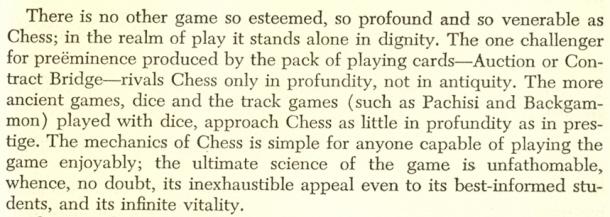
(6060)
Concerning the remark ascribed to Ely Culbertson ‘There is no other game so esteemed, so profound and so venerable as chess; in the realm of play it stands alone in dignity’, Oliver Beck (Seattle, WA, USA) notes that a condensed version appeared on page 1 of The Personality of Chess by I.A. Horowitz and P.L. Rothenberg (New York, 1963):
‘In the realm of play, chess stands alone in dignity – Geoffrey Mott-Smith.’
No source was given. We add that in Rothenberg’s obituary of Mott-Smith on pages 302-303 of the October 1960 Chess Review it was stated that the quote in Culbertson’s Hoyle was written by Mott-Smith:
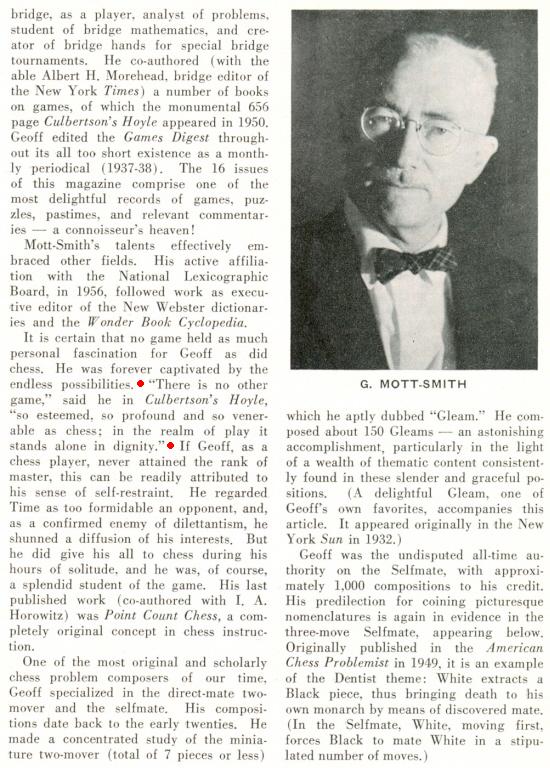
Extract from page 302 of Chess Review, October 1960
The grounds for attributing the quote to Culbertson are thus evaporating.
Mott-Smith brought out an edition of Hoyle’s Rules, jointly with Albert H. Morehead, in 1946, four years before the edition which carried Culbertson’s name (and which, as mentioned in C.N. 6060, was co-edited by Morehead and Mott-Smith). Did the quote under discussion also appear in the 1946 volume?
(6072)
A copy of The Penguin Hoyle by Albert H. Morehead and Geoffrey Mott-Smith (New York, 1946) is now to hand. The chess section (pages 196-205) does not contain the quote under discussion.
The back cover provides some biographical information about the co-authors:
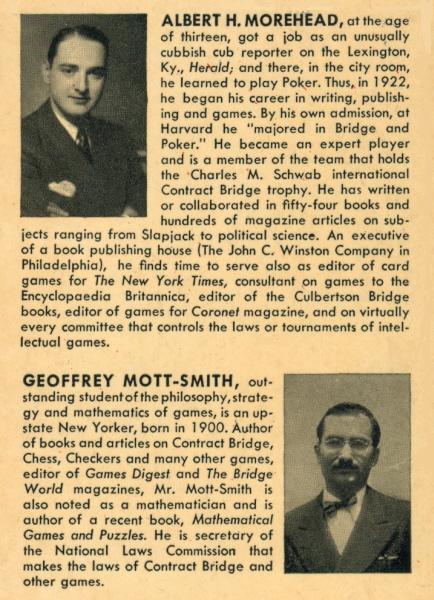
(6080)
Although many websites have historical currency converters purportedly able to show today’s equivalent of, for instance, Morphy’s fee for his New York Ledger column, the London Rules purse, or the prize-money for the 1972 Spassky v Fischer match, the results may vary wildly according to the criteria used. Is there a consensus among economists as to the best way of using such on-line tools, if at all?
Readers of books by Ely Culbertson will see, regarding bridge, far more references to money and to sales of books/magazines – and much higher figures – than exist in the chess world. As a further illustration, we quote some passages from Culbertson The Man Who Made Contract Bridge by John Clay (London, 1985):
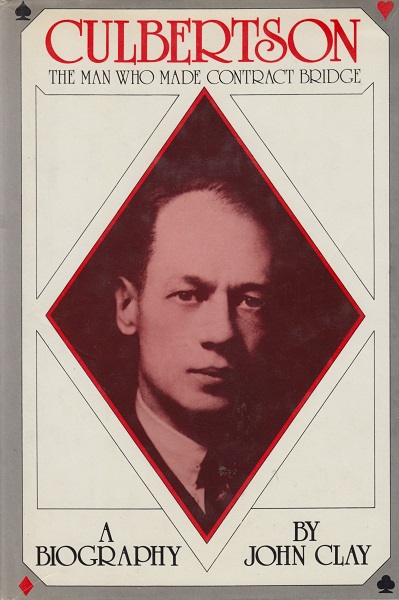
John Clay’s book has references to Marshall and Janowsky (page 58), Lasker (page 102), Capablanca (page 119) and Rice (page 178).
See too the chapter ‘Lasker as a Bridge Expert’ by Bob van de Velde on pages 214-269 of Emanuel Lasker edited by Richard Forster, Michael Negele and Raj Tischbierek (Berlin, 2020).
To the Chess Notes main page.
To the Archives for other feature articles.
Copyright: Edward Winter. All rights reserved.